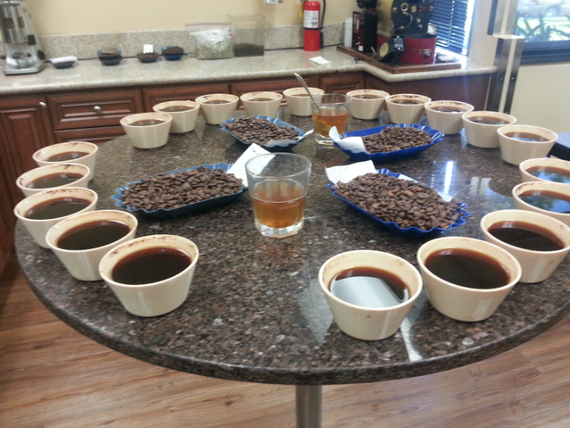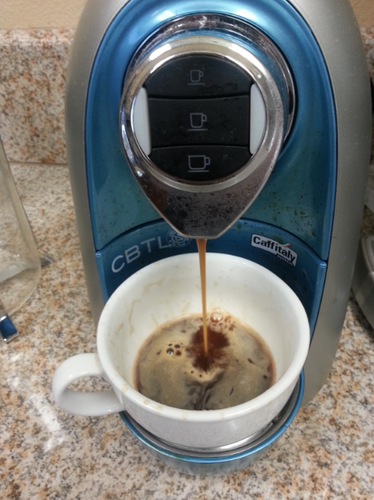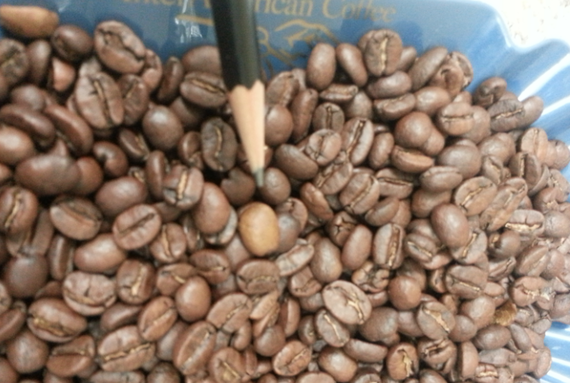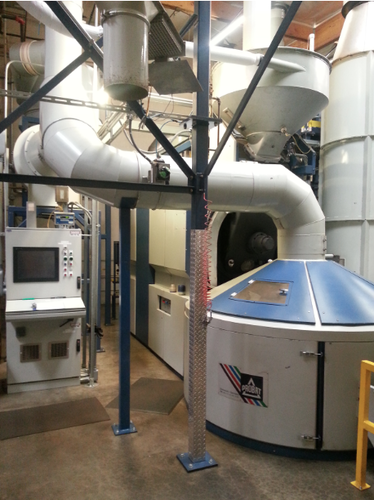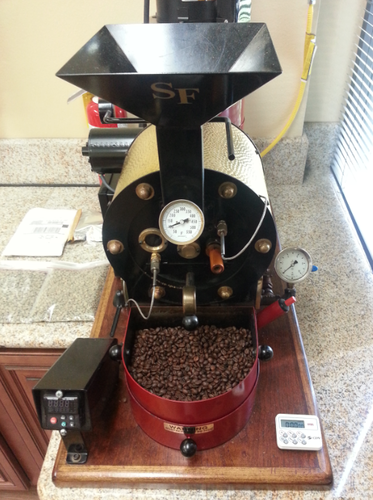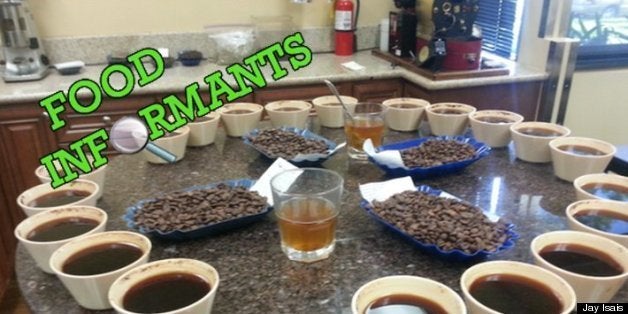
Food Informants is a week-in-the-life series profiling fascinating people in the food world. We hope it will give you a first-hand look at the many different corners of the food industry. Know someone who would make a great Food Informant? Tell us why.
Nearly seven million pounds of coffee beans pass under Jay Isais’s eyes and nose each year at The Coffee Bean and Tea Leaf’s Research and Distribution facility in Camarillo, CA. Isais oversees the blending and roasting of all of those beans. Isais began his career in the early ’80s with Hillside Coffee. He then held operations management and buying positions at Brother’s Gourmet, Gloria Jean’s, Coffee People Worldwide, and Diedrich Coffee before joining The Coffee Bean & Tea Leaf in 2000.
Isais’s primary responsibility day to day is making sure the quality of Coffee Bean & Tea Leaf’s coffee is, as he says, “perfect from start to finish.” To accomplish this, he evaluates shipments of green beans, working with Master Roaster Jesse Martinez-Beltran on finding the perfect roasts for each varietal, or blend, and tasting the brewed product. Isais also spends much of his time sourcing coffee from the finest coffee farms around the world, establishing and maintaining one-on-one relationships with coffee growers at the points of origin -- a hallmark of the company’s philosophy.
Isais is a founding member of the Roasters’ Guild, is a volunteer instructor for the Specialty Coffee Association of America and a certified judge for the Cup of Excellence® program. He is also a licensed Q grader and an APICS Certified Supply Chain Professional. Isais is additionally a judge at cupping competitions around the world, most recently the Hawaii Coffee Association’s cupping competition.
Read on to learn about how Jay selects what coffee beans to purchase.
Monday, May 20
6:15am: I walk downstairs to make my morning pot of coffee for my wife Connie and me to drink using my trusty thermal carafe drip coffee brewer. There are fancier brewer options, but my wife is very attached to the coffee from this unit. It is dependable and predictable, and most importantly it does not have a warmer to burn the coffee in the pot after it has been brewed. This morning's selection is Guatemala Antigua, Finca San Miguel. Guatemala coffee is the perfect "drink anywhere anytime" coffee, and Antigua coffees are the most sophisticated and fragrant of all Guatemala. I am sad to be using up the last of the coffee in this bag, as it is one of my all-time favorites. With the gurgle of the siphon pump reassuring me that I did remember to press the start button this morning, I make my way to my computer to check the coffee market on the ICE web site, and notice that it is down 1.6 cents this morning in early trading.
9:30am: After checking the market again (down nearly 3 cents now, at least for the moment) and responding to the morning's emails at the office, I go to the cupping lab to cup this morning's samples. Today we have four samples to cup and approve. There is a Sumatra, two Costa Rica, and a Mexico. I open a new session on my new Android app "Cupping Lab" to record our results for the day. It is a really nice app. The user menu is very straightforward and easy to use, and other features and edits are available by logging into the application website and retrieving the data from the cloud. The application contains the identical elements found on our cupping forms. We analyze fragrance/aroma, flavor, acidity, body, balance, sweetness, uniformity, clean cup, aftertaste and overall impression. Each category is worth a maximum of 10 points. A coffee must score a minimum of 80 points to be considered "Specialty Coffee," and for most of our coffees, we expect much higher scores than that. Fortunately, today's samples do not disappoint and I email the resulting approvals to each respective supplier.
10:15am: After our cupping session I reward myself by brewing the Mexico in our lab drip brewer and enjoying a cup. It had a gutsy body and pleasant spicy herbal note in the finish that I wanted to experience with a full cup.
11am: Master Roaster Jesse Martinez and I are testing the latest prototype for a reusable capsule for our CBTL single serve machine. It is a molded plastic capsule with a twist on top, which customers can fill themselves and reuse. The early samples needed some minor changes, so I am eager to try out the new version. The new prototypes are made with a different type of plastic that is more durable and heat resistant, so we shall see what happens. We find that after a dozen cycles that these perform better than the last version, but we are still not satisfied and conclude that more work is needed. Off to send an email to the injection molding company with our feedback. On the plus side, I was able to drink some of the coffee from the test, and it was quite good.
11:30am: Checked the coffee market close to see the settle is 1.75 cents down. I make a note to review my purchases that still need to be priced in anticipation of further decline in the market.
4pm: Conference call to discuss new 2.5 pound and 3 pound retail coffee items for a large club store account in the San Francisco region. Apparently our coffee is so popular; people want it in larger bags. I must agree that sometimes two pounds is just not enough coffee!
Tuesday, May 21
6:20am: Morning coffee, I brew a pot of Costa Rica Tarrazu in the trusty drip brewer. It is a light bodied crisp cup with a crisp acidity and a clean finish. Market check time while the coffee drips, and for the second consecutive day the market opened lower. I make a note to fix a few contracts when I get to the office if the level holds.
8:30am: I check the market and see that it is still lower. I send an email to one of my suppliers and instruct them to fix several of my contracts at the current market. This will establish the final price that I will pay for the coffees against these contracts, and will afford us a better chance of avoiding any price increases to our customers based on higher coffee costs.
9:30am: I enjoy a cup of Ethiopia Yirgacheffe from our Bunn Trifecta Machine in our cupping lab. The Bunn Trifecta is a sophisticated brewer that is designed to produce a single cup of coffee at a time and give the user the ability to control water volume, brew time, turbulence, pre-infusion, as well as the force of air flow through the chamber at the end of the cycle. The longer I am in this business the more I come to appreciate that the coffee experience is as much about "when," "where," and "how," as it is about "what." This is to say that the quality and specific flavor and aroma we get from a particular coffee can be wildly different in varying circumstances, even though it is the same coffee that we are using.
10:30am: I leave for the Four Seasons Westlake Village Hotel to survey the brewing equipment for our upcoming 50th Anniversary International Conference. Brewing good coffee in a hotel environment can be a challenging experience, and it is a good idea to get a first-hand view of the facilities and staff before planning an event. I reflect on the complexities of brewing as we walk through the property to see what equipment they will be using for our event. There are three different locations in the hotel that will be utilized for our conference. The upstairs restaurant has a 1.5 gallon brewer from one manufacturer, and downstairs was a 1.5 gallon brewer from another manufacturer. Our coffee was perfect from the upstairs brewer, both in strength and flavor profile, but it was a little strong on the unit downstairs and will have to be adjusted slightly. Aside from tasting the coffee, we use a device called a "TDS" meter to measure the amount of coffee solids in the beverage. Ideally, brewed coffee should contain 1.1% - 1.3% coffee solids resulting from 18%-22% extraction. Roasted coffee is only 30% extractable with water, so the goal is to remove two-thirds of the available solids from the coffee during the brewing process. This provides the best balance of strength and flavor. The last unit we test is in the main brewing station behind the ballroom, and it brews a whopping five gallons at a time! After testing a batch, we decide to use more coffee in these units for our conference. We say goodbye to the very competent staff of the Four Seasons and know we will be in good hands for our event.
1pm: On our return to the office, we find that lunch has been brought in from a local BBQ restaurant called Wood Ranch. They do a great job and are very well known in Ventura County, as well as much of Southern California. There is tri-tip, chicken, salad, macaroni & cheese, and their famous peanut coleslaw! I don't have to be asked more than once to help myself.
4pm: The Rabbi from our kosher supervisory office shows up unannounced for an inspection of our facility. He is a great guy, and painstakingly looks at virtually every label on each of the teas, spices, botanical products, and flavorings that we store in the facility. Everything is in order, but I am reminded that I need to add one new supplier of tea bag material to our formal list of approved vendors. The supplier is already under supervision by the Rabbi's office so it has been pre-approved.
4:45pm: I bid the Rabbi farewell and return to my desk to read and answer more endless emails!
Wednesday, May 22
6am: Today's morning pot of coffee will be Colombia from the southern state of Narino. Coffee is grown at very high elevations in Colombia and particularly in the south where it is nearer to the equator. Coffee in this region can be grown above 6,000' and it is usually very complex with both outstanding body and a fine acidity that leads to a very well rounded and complex cup.
8:45am: I respond to an email from our Ethiopia supplier who is extending an invitation for us to visit him in the fall. He is one of the most amazingly energetic and altruistic men I have met over my career. He started a student self-help association called KIMSA out of his home in Addis Ababa, providing education, arts and training for underprivileged youth. Over the years it has grown to include quite a sizable enrollment. We are proud to be a modest supporter of this project, as part of our "Caring Cup" program. I let him know how much we are looking forward to visiting him and meeting the students of KIMSA as soon as we can arrange a visit.
9am: Today's approval samples include a Papua New Guinea, and three Brazils. The Brazils are solid and sweet, but the Papua New Guinea is spectacular! This Estate is always great, but this shipment is even better than usual. I make a note of the lot number so I can take a pound home and drink it when it arrives at the roasting plant!
9:30am: I check the market again and notice it is creeping up a bit today. I feel good about my decision to fix a few yesterday.
11am: I facilitate our weekly Q&A Meeting with the production team. Today's topic is focused on the organization and aesthetics of the room that we use for the production of tea bags. This function was relocated from a different part of the facility, and we are still determining the best layout and support furniture. We want to make sure that we provide for the comfort and convenience of our staff, while also maintaining a clean and hygienic area to promote efficiency and improve food safety. We agree on some new tables and racking that we want to order for the room. Everything else is going well with the production team.
Thursday, May 23
5:51am: I receive an email from one of our primary Sumatra suppliers with a proposal about a potential collaboration with The Sumatra Tiger Trust. This is really exciting news and very opportunistic, as I have been looking for just the right fit for adding Indonesian project to complement our "Caring Cup" program. I decide that I will make Sumatra coffee this morning in honor of this new opportunity! As a quality origin, Sumatra coffee has more "good" variations than any other producing country in terms of what people look for. Sumatra can span the range from sweet, to acidic, to very earthy (borderline musty). My perfect Sumatra has a cedar wood aroma, apricot/butterscotch flavor, and dry finish. Although good Sumatra coffees have a fair amount of acidity, theirs tend to be the "stealthy" type that lurks in the background of the flavor profile, rather than assert itself as a primary element. When you look for it it's there, although not generally prominent.
8:45am: Today we have three Costa Rica, and two Colombia samples to cup. One of the Costa Rica samples has a few visible "quaker" beans in it. A "quaker" is an immature bean that did not develop its full density while it was inside the cherry. It can happen due to uneven ripening of the fruit on the tree, or by picking unripe fruit. Quakers are much easier to distinguish after roasting, when the beans are generally a much lighter color in contrast to the rest of the batch. An occasional quaker is not a cause for concern, but several visible in a single sample means that we will be rejecting this lot. I email the supplier to give them the news and request a different lot.
9am: I see the market is down again today, and I send an email to fix a couple more contracts.
10:30am: Conference calls to discuss a product rollout at a new account. There are quite a few details such as carton and pallet labeling, barcode format, electronic data interface (EDI) and order documentation requirements that need to be sorted out. Our packaging equipment is equipped with printers that can imprint our bags and cartons with specific information and barcodes relative to the items and manufacturing dates.
2pm: I walk through the roasting are to double check my information on a new coffee in the roasting log. We are doing a Yellow Caturra from Maui for our conference, and later in the year as a limited coffee. "Caturra" is a natural hybrid cultivar of the Arabica species that is common to Latin America. Like most coffee types, regular Caturra ripens to a deep red color, but Yellow Caturra ripens to a deep yellow color, thus its name. Maui is gaining recognition as a quality origin, and this coffee is very drinkable. I remember my early days roasting on a 20 pound production roaster as I am standing in front of our Probat R1500R which does 600 pound batches every 12 minutes throughout the day!
3pm: I have a call with our project coordinator for our CBTL single serve program. She informs me of upcoming capsule production needs in Italy that I need to order and ship green coffee to support. It is great to have our capsules manufactured by one of the innovators of espresso and coffee capsule technology, but it has been quite challenging (not to mention requiring several trips to Italy over the last two years) learning to manage the process from Southern California. Talking about the product reminds me that I want an espresso, so I pull a nice shot of Italian Espresso from the CBTL Kaldi machine in my office!
Friday, May 24
6:15am: I make a pot of nice Kenya AA this morning. My wife is not a big fan of African coffees since she uses creamer in her coffee. The higher acidity of Africans tends to conflict with cream and will cause a slightly sour aftertaste. I suspect she will have a comment for me when she tastes her first cup, but sometimes I just have to drink Kenya, so this morning I will risk it.
7am: My wife wrinkles her nose at me as she walks by, asking "What's up with the coffee this morning"? I am caught!
9am: Jesse has the day off today, so I have sample roasting duty. There is only one sample that I need to cup in order to make an approval before the weekend, so I roast it and put it on the table. It is a Guatemala and it passes the cup test with flying colors. I like it so much; I want to make a cup to drink. Question is, with what? I usually French press my coffee at work as it provides the "truest" expression of the coffee (in my opinion) and the one that is closest to our "cupping" method. This time I decide to use a Hario dripper for a change. Drippers are common to third-wave coffee houses where the "theater" of coffee is as important as the contents of your cup. It is a good way to brew a small quantity of coffee and looks cool, but is not really any better than a properly calibrated commercial brewer. Most people identify this brewing method with Melitta, a company that makes single cup cone drippers as well as dominating much of the paper filter market in supermarkets. I really like the aesthetics of the Japanese made Hario products better than the plastic Melitta units, however, the quality of the beverage is just as good from a Melitta cone. It is really important to understand the method and specific equipment that you use to prepare your coffee for best results. In this case, my coffee is delicious the first try.
10:30am: I have a meeting with our franchise field team to discuss details about our upcoming conference. The theme is about our 50 year tradition and the inspiring thing, is that we are writing that tradition daily, along with all of our team members and customers.
2:30pm: I am updating my coffee data spreadsheet with usage data through the week of May 17th. We are currently at a run-rate of seven million pounds of coffee per year. It is amazing to think that most of the world's Specialty Arabica coffee comes from small family farms of only a few acres. On average each coffee farm contains about 500-750 trees per acre, each tree producing 1-2 pounds of coffee per year for an average of 1,000-1,500 pounds of green coffee per acre. From that, only around 20 percent meet the quality standards for Specialty Coffee. Each pound of roasted coffee contains between 2,500-3,000 beans. Coffee is a lot of work, and great coffee is even more work, but it is well worth it!
3:30pm: I go out to the warehouse to hang some additional flags to represent countries where we have stores. We currently operate Coffee Bean & Tea Leaf stores in 28 countries. I appreciate the magnitude of that as I unpack a few of the flags. Many of our International partners will be visiting us at the roasting facility next month while attending our 50th anniversary conference. We want them to know that we are proud to be serving customers in their countries.
5:20pm: I log onto The Sumatran Tiger Trust website and make a donation while reading about the variety of elements that constitute their conservation program. As a Natural Resource major, I can appreciate the need for careful management strategies in seeking solutions to endangered species, shrinking forest habitat, and growing populations in countries like Indonesia. It is a delicate balance between humans and nature, but I am optimistic that solutions will be found.
See more Food Informants below:
